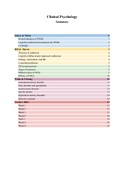Summary
Clinical Psychology - Summary Exam Material
- Course
- Institution
This is a compact summary of 24 pages of all the necessary exam material of Clinical Psychology. This includes the five articles and all the lectures. I tried to make it as structured and clear as possible and integrate everything. Good luck with the exam!
[Show more]



